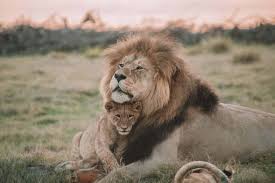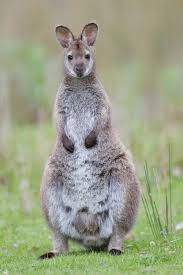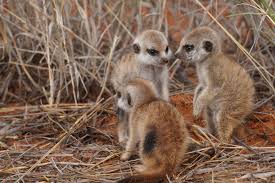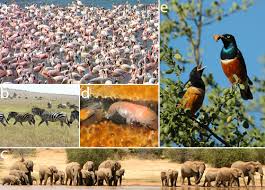Behavioral ecology, also known as ethoecology, is the study of the ecological and evolutionary basis of animal behavior, focusing on how behavior enables animals to adapt to both intrinsic and extrinsic environmental factors.
This field developed from ethology, especially after Niko Tinbergen, a foundational figure in animal behavior studies, introduced the four causes of behavior.
When an organism has a trait that offers a selective advantage meaning it has adaptive significance in a new environment, natural selection tends to favor it. Adaptive significance refers to how a trait increases an animal’s chances of survival and reproduction.
1. Example of Adaptive Traits in African Mammals
The evolution of flight across different animal groups such as reptiles (Pterosaur), birds, insects, and mammals (bats) demonstrates the adaptive significance of flight.
For many species, flight enhances predator evasion and mobility between habitats, thereby improving survival and reproductive success. The organisms adapting to flight possessed “pre-adaptations” enabling behavioral and anatomical changes.
For example, feathers in birds initially evolved for thermoregulation and later supported flight; similarly, insect wings evolved from enlarged gill plates used for gliding over water.
At each stage, small improvements led to higher energy efficiency, reduced energy use, or increased mating success, allowing the genes responsible for these traits to spread within populations. However, if genetic or phylogenetic limitations prevented necessary variation, these behaviors could not evolve.
2. Avoiding Unsupported Theories in Behavioral Studies
It is essential to avoid forming speculative explanations for traits without evidence. Creating “Just So Stories” about adaptive traits has been heavily criticized. Stephen Jay Gould and Richard Lewontin (1979) referred to this tendency as the “adaptationist programme”. Sound scientific practice requires that hypotheses about adaptations be tested theoretically or experimentally.
3. Testing Behavioral Hypotheses
For instance, the evolution of insect flight has been investigated using wing manipulation experiments. Observational data that meet proposed criteria also provide support. For example, when birds face no threat from predators, they may lose the ability to fly.
Functional wings require substantial energy, which could instead support survival or reproduction. This trend is evident in flightless island birds like the Kakapo, Penguin, and the extinct Dodo that evolved in predator-free environments.
Read Also: Bedbugs: Description, Damages Caused, Control and Preventive Measures
Understanding Proximate Causation in Animal Behavior

1. Proximate Causation and Behavioral Development in African Mammals
Proximate causation has two components: ontogenetic and mechanistic. Ontogenetic factors encompass the animal’s lifetime experiences, from embryo to death, including learning and inherited genetic traits. Mechanistic factors refer to bodily processes like hormonal effects and neural systems that produce specific behaviors.
Application of Optimization Theory in Behavioral Ecology
1. Optimization Strategies in African Mammal Behavior
Behavioral ecology uses concepts from optimization theory to analyze animal strategies. Optimization identifies behaviors that provide the best outcome under given constraints. A basic method is cost-benefit analysis: if the cost of a behavior exceeds its benefits, it will not evolve.
A trade-off is usually involved, as animals rarely invest fully in one behavior. For example, ectothermic animals like lizards must balance foraging time with basking to raise body temperature. While basking enhances digestion, it reduces foraging time and increases predator exposure.
Therefore, optimal basking time reflects the balance between warming, foraging, and predator avoidance demonstrating how intrinsic and extrinsic factors shape behavior.
2. Example: Lack’s Brood Reduction Hypothesis in Birds
Lack’s brood reduction hypothesis, named after David Lack, offers an evolutionary explanation for birds laying eggs with time delays, resulting in chicks of different sizes. This strategy provides ecological insurance: in poor conditions, larger chicks survive; in favorable conditions, all chicks may survive.
Read Also: 10 Medicinal Health Benefits Of Jakhya (Cleoma viscosa)
Differential Reproductive Success in Mammals

1. Natural Selection and Behavioral Adaptations in African Wildlife
Behavior is subject to natural selection like any physical trait. Animals using optimal strategies suited to their environment typically produce more offspring than others. Those that reproduce more successfully are said to have higher fitness. As environments shift over time, behavioral strategies must adapt.
A behavior beneficial today may become less effective in the future. Behavioral ecology helps track these changes. As Theodosius Dobzhansky noted, “nothing in biology makes sense except in the light of evolution.”
Understanding Evolutionarily Stable Strategies in Animal Populations
1. Application of Game Theory to Mammal Behavior in Africa
The success of a social behavior depends partly on how others behave. For instance, the effectiveness of a threat by a male depends on how likely rivals are to retreat or fight.
When such interactions become common, a stable pattern of behaviors may form, known as an evolutionarily stable strategy (ESS). John Maynard Smith (1982) introduced this concept from economic game theory, applying Nash equilibrium principles to behavioral evolution.
In game theory, an ESS is a strategy that, once common in a population, cannot be overtaken by any alternative strategy. This means each animal adopts the best response to others’ behavior. In symmetric two-player games, the strategy must be the best response to itself.
Therefore, ESS represents a behavioral equilibrium. Because fitness is influenced by what others are doing, behavioral strategies are frequency-dependent and shaped by both environmental and social factors.
Tinbergen’s Four Questions in Behavioral Ecology Research

1. Key Questions in Animal Behavior Analysis for African Species
Behavioral ecologists often study four key questions, developed by Niko Tinbergen:
- What causes the behavior (environmental or internal factors)?
- How does the behavior develop during the animal’s life?
- What is the function or benefit of the behavior?
- How did the behavior evolve?
2. Explanation of Tinbergen’s Questions
The first question considers hormonal or environmental triggers, such as territorial disputes. The second question involves genetics and past experiences similar to the nature versus nurture debate.
The third focuses on how the behavior helps the animal adapt or survive, such as losing territory. The fourth question explores the origins and evolution of the behavior, such as flight instincts becoming exaggerated due to modern conditions.
Relevance and Importance of Behavioral Ecology to Agriculture and Conservation
Behavioral ecology is valuable in multiple ways: it helps interpret social behavior, supports neurobiological studies (neuroethology), addresses environmental issues, informs wildlife conservation, and attracts interest in biological sciences. Understanding animal behavior also enhances public awareness, reflected in the popularity of documentaries, books, and safari experiences.
1. An Example of a Behavioral Ecologist
Dr. Jennifer Borgo, a visiting assistant professor at Coker College in Hartsville, SC, is a behavioral ecologist who studies various bird and mammal species, including flying squirrels, ducks, woodpeckers, and grouse.
Her focus is on ultimate behaviors (Tinbergen’s third question), while proximate behaviors align with the first question. Dr. Borgo specializes in interspecific interactions how different species interact, such as predator-prey relationships.
This article has presented the following key concepts: the meaning of behavioral ecology, ontogenetic and mechanistic factors under proximate causation, the significance of Tinbergen’s Four Questions, optimization theory, and the role of evolutionarily stable strategies in shaping behavior.
Do you have any questions, suggestions, or contributions? If so, please feel free to use the comment box below to share your thoughts. We also encourage you to kindly share this information with others who might benefit from it. Since we can’t reach everyone at once, we truly appreciate your help in spreading the word. Thank you so much for your support and for sharing!

